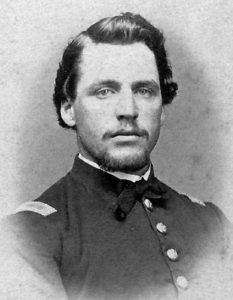David Reed: Shiloh’s Veteran Historian

Gettysburg has John Bachelder. Antietam has Ezra Carman. Shiloh has David Reed.
Each of these men forever influenced the battlefields they devoted their lives to documenting. Two of them–Carman and Reed–participated in the battles they studied.
I’ll admit, Carman and Bachelder were known to me. Until recently, I had never heard of David Reed. His influence on the Shiloh battlefield is still apparent today and he, just as much as Bachelder or Carman did for Gettysburg and Antietam, forever shaped the way modern historians study the Battle of Shiloh.
David Reed celebrated his twenty-first birthday in the camp of the 12th Iowa Infantry at Pittsburg Landing four days before a surprise Confederate onslaught brought chaos and destruction to the woodlots and fields around the Tennessee River landing. Federal soldiers defiantly battled all day, desperately holding back their enemy. No Union defensive position became so mythologized and well-known as the Hornet’s Nest–a name given by the buzzing sensation Federal bullets created for the attacking Confederates.
There at the Hornets’ Nest, young David Reed shouldered a rifle alongside his comrades. Late in the fight, just as the Federal position began to collapse, a bullet struck Reed in the thigh. Wreathing in pain, Reed remained on the battlefield, unattended, until the next day.
Despite his wound, Reed rebounded and fought through the rest of the war. He returned home to Iowa and assumed several different government posts from 1867 to 1895. During those years of further service to his state and nation, Reed was active in local veterans’ organizations and became the historian of two of them.
In 1890, the Federal government established the first five national military parks: Chickamauga and Chattanooga, Antietam, Gettysburg, Vicksburg, and Shiloh. Due to his network of political connections, Reed received his third official appointment as a Civil War historian in 1895, this time as the secretary and historian for the Shiloh National Military Park Commission. To construct the history of the battle, Reed turned to the Official Records. But, like Bachelder and Carman, Reed had the tremendous benefit of consulting with veterans themselves.
Reed helped place the scores of monuments that ornament the Shiloh battlefield. He also authored the approximately 400 tablets marking troop positions on the battlefield and created two detailed battlefield maps. Lastly, Reed published The Battle of Shiloh and the Organizations Engaged, a work still consulted by Shiloh historians today.
Reed’s work left a profound impact on the Shiloh battlefield. Despite being felled and maimed by a Confederate bullet, he ensured his work was “complete, impartial, and correct” so that his history represented “nothing but the truth.”

Understandably, Reed could not escape inputting his own bias into his work, whether he did so consciously or subconsciously. His works and interpretation stressed the importance of the Hornets’ Nest in the April 6 action and the role of his own regiment in that fight, assertions now under fire by Shiloh’s latest pool of historians.
Regardless of his own interpretations of the battle, Reed’s impact on the Shiloh battlefield today is inescapable. His tablets and the monuments he helped to place pock the open fields and woodlots of the park today as visitors drive along the battlefield’s tour route.
The group of historians that included the likes of Reed, Carman, and Bachelder tapped a resource that modern historians dream of: the battles’ veterans. Thus, these men laid the groundwork for all of us who follow in their footsteps.
One cannot study Gettysburg without consulting John Bachelder, one cannot study Antietam without reading Ezra Carman’s prose, and one certainly cannot learn about Shiloh without utilizing the resources David Reed created, including the battlefield itself.
Here is the link to Timothy Smith’s 2003 article on Reed in Annals of Iowa:
https://ir.uiowa.edu/cgi/viewcontent.cgi?article=10709&context=annals-of-iowa
Thank you! I have not seen this one before.
Thanks. Major Reed’s book “The Battle of Shiloh and the Organizations Engaged” is available on archive.org https://archive.org/details/battleofshilohor00reed/page/n4/mode/2up
In 2008 Dr. Smith had a book published on the creation of the first five National Military Parks in the 1890s, which includes David Reed and Shiloh, called “The Golden Age of Battlefield Preservation.” I was only at Shiloh once back in 1997 and I am planning on re-visiting the battlefield. Its important to know how and why battlefield parks were created when visiting.
Reed also played a conspicious role at Nashville, where he led the attack on Redoubt No. 2 after Colonel Sylvester G. Hill was killed.
Thanks Sean. Another new tidbit for me.
Reed’s meticulous work – even with whatever bias he brought to the table – has made for an exceptional park experience at Shiloh.
Dave: Seconded. The meticulous establishment of troop positions, etc. is invaluable, even with some interpretation bias.
Kevin: Thanks for this article. As you suggest, Reed (understandably based on his personal experience) saw the Hornet’s Nest as the pivotal event of the first day. That interpretation was official for decades before modern historians,such as Tim Smith, took another look.